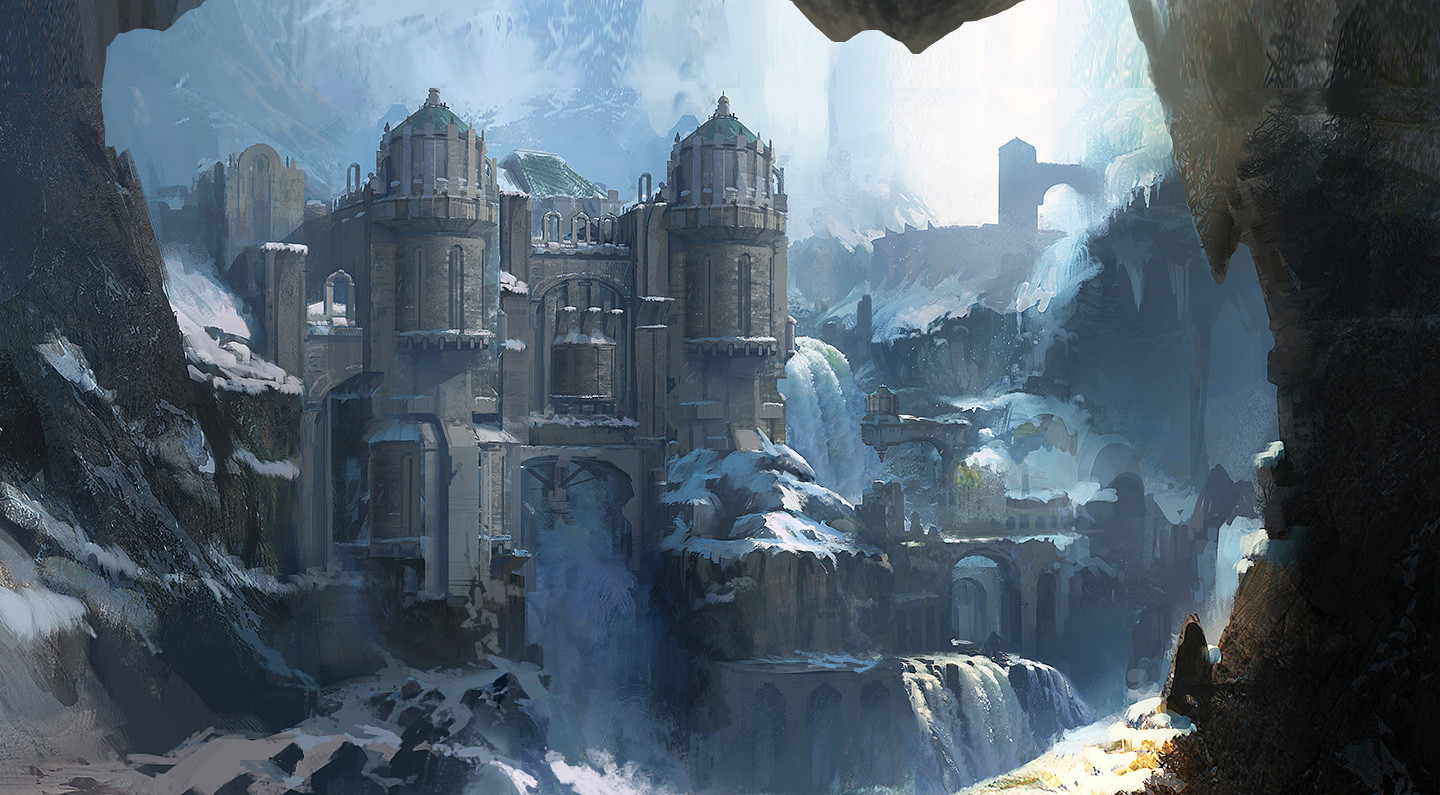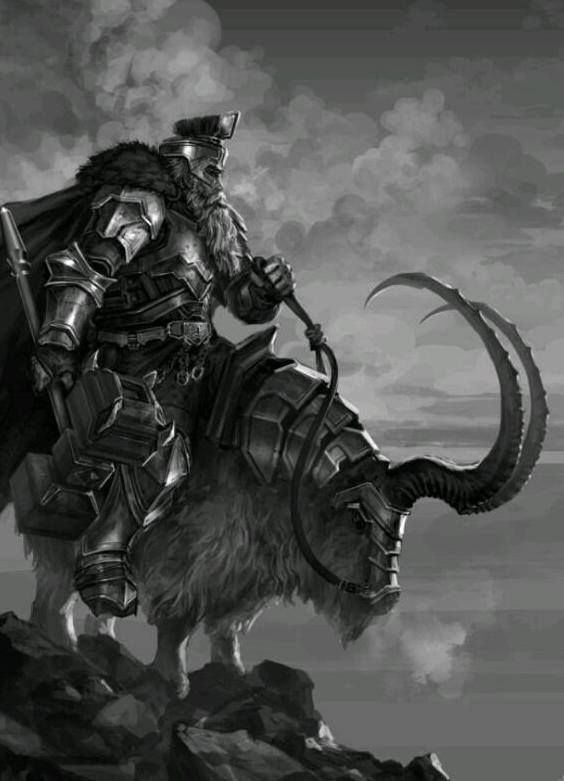Dwarf
The dwarves are a race of stocky, mountain-dwelling mortals created by the Gilded Crafter, Zwakhasis. As one of the Elder Races of Holos, they have a rich and storied history, often establishing themselves as bastions of power and influence from the mountainous strongholds they control. Unlike other races who often adapt and adopt the cultures and beliefs of the states they integrate into, many dwarves remain stalwart adherents to an ethno-specific religion called Zwaism, which centers on the worship of their creator, Zwakhasis, over any other deity including Zwakhasis's fellow Heavenly Councilors.
Basic Information
Anatomy
Dwarves are known for their short and stocky size, with most dwarves standing well under 5 feet tall. However, despite their short stature, dwarves are far more compact than human, often weighing the same as a human two feet taller than the dwarf.
Dwarf skin ranges in hue from pale alabaster to earthy brown. Two of the subraces of dwarves—the mountain dwarves and the hill dwarves—do have more common skin tones among their kin, with mountain dwarves who dwell underground for most of the year having paler skin and lighter eyes and hill dwarves who more regularly work in the sunlight boasting warmer, tanned skin colors.
Perhaps the most defining biological trait of the dwarves is their prodigious hair growth. Dwarves of both sexes grow hair on their heads, face, and across the whole of their body; likely an adaptation designed to help them regulate their body temperature in their alpine environment. These beards range in hue but in general, mountain dwarves have fairer hair than their hill dwarf cousins.
The duergar, a corrupted race of dwarves banished to the Underdark bear the Deep Mark bestowed by the gods for their cruelty. As a result, duergar have unnaturally pale hair and charcoal black skin, similar to the drow or deep gnomes.
Genetics and Reproduction
Dwarves reproduce in much the same way as the other mortal species. Unlike many of the other Elder Races, dwarves are not cursed with exceptionally slow gestation periods, bearing children after a period of about eleven months of gestation.
Growth Rate & Stages
Dwarves, like other Elder Races, are particularly long-lived. They mature at around the same rate as humans, but are considered still subadults by the community until age fifty. Dwarves typically live two centuries, though some blessed individuals have seen three hundred years.
Ecology and Habitats
Dwarves are highly adaptable, yet they fell most at home with great walls of stone—either natural or constructed—around them. The sturdy body of a dwarf is perfectly adapted to the rugged lifestyle of the hills and mountains, enabling them to summit great peaks and not mind the lack of oxygen and endure the bitter winds thanks to their thick hair and short stature. Some dwarves do live in more lowland areas where the farming of cereal crops is easier and the soil less rocky. Some enterprising dwarves have learned how to survive entirely within mountain fortresses thanks to the creation of moon wheat, a kind of wheat grass that needs only the light of an everflame torch or candle crystal to photosynthesis. In these rugged environments, many dwarves raise animals such as markhors, yaks, and pigs that can survive the hostile conditions and still be of use to the community for milk, meat, and animal labor.
Dietary Needs and Habits
Dwarves are hardy individuals who enjoy drinking and eating great sums of food. Few dwarves are vegetarian and the concept of going a meal without any meat is met with shock and derision. Subterranean dwarf societies usually grow moon wheat, mushrooms, and other subterranean plants to supplement their diet of markhor, yak, and pig meat.
Additional Information
Social Structure
Broadly speaking, most dwarf societies maintain a clan-based system of interrelation. The clan is the basic unit of dwarven society, an extended family that dwells together. Everything a dwarf does in life is devoted to improving or helping the clan, bringing security and stability to its members and greater glory to the group. The most important clan members to any dwarf are the members of one's immediate family, because the instinctive connection between parent and child is stronger than the attachment between unrelated clan members. Nevertheless, the distinction is so slim as to be unnoticeable to outsiders—dwarves will endure hardship or lay down their lives for any of their clan mates, whether related to them by blood or by the devotion that holds the clan together.
Geographic Origin and Distribution
Dwarves are found on every continent of Holos. Their largest population centers are in the Shanindar of Nioa, the Basceron of Auloa, the Rhapalkan of Iroa and the Maddrellan Highlands of Mérulad. At one point, the Bluefrost Mountains on the Varangian Peninsula boasted a large population of mountain dwarf clans, but those kingdoms crumbled and are almost entirely extinct now thanks to the migration of the Varskogan peoples some two hundred and fifty years ago. The survivors of that invasion and their offspring now live in thralls to the largely human Varskogan population and have all but forgotten their Old Varangian customs.
Perception and Sensory Capabilities
Dwarves are well-accustomed to life underground and have superior vision in dark and dim conditions. They can see in dim light as if it were daylight for up to sixty feet and in darkness an additional sixty feet as if it were dim light and cast in shades of grey.
Civilization and Culture
Major Organizations
The largest religious organization that many dwarves are a part of is the faith of Zwaism, an ethno-specific monotheistic religion centered on the continent of Nioa but claiming adherents across Holos.
The largest political organization that counts dwarves among their leadership and is largely comprised of dwarves is the Shanindar Empire, a large, ancient state that has endured in the mountains of Nioa since the Mithril Era.
Beauty Ideals
Though not universal, many dwarves express their understanding of beauty through their hair.
Common Customs, Traditions and Rituals
Dwarves cut and restyle their hair at various points throughout their life to symbolize their changing body and place in society.
Young dwarves under the age of thirty almost never decorate their hair. They lack beards and so keep their hair in loose tails or ribbons. Braids or beads on a young dwarf appears like lipstick or rouge on a human child—garish and almost an attempt to sexualize someone that has not fully developed. A dwarf's beard is considered the greatest symbol of their own agency and their adulthood. If a dwarf's beard has not fully come in by the time they reach sexual maturity, most clans consider that dwarf still a teenager until the beard is full and present. For this reason, a dwarf's beard is never cut, for it would be a kin to cutting off one's manhood or womanhood.
By adulthood, dwarves of both sexes can grow beards and often braid them to keep them in check. A dwarf that wears their hair loose is seen as immature and lacking the discipline to keep their things together. Beads, caps, and rings are earned through deeds, with dwarves always being careful not to improperly bead their hair—lest they be called dishonorable or a liar. Additionally, single or unmarried dwarves do not cut their hair after reaching adulthood apart from slight trims.
Upon reaching their final century, dwarves wear their hair up if long enough. A balding elderly dwarf will often use sheep's wool or horse hair to create the illusion of having long enough hair. At this point in their lives, it is expected that a dwarf has many beads, caps, and other decorations in their hair, symbolizing a life long lived and full of deeds.
Newly married dwarves cut the hair on the back of their heads as a sign of their devotion to one another. All dwarf societies allow divorce, but only once the hair of both parties has grown back to the shoulders—usually a period of about two months. Married dwarves almost always cap their braids and never wear rings around their fingers. Rings above the cap are exchanged every ten years a dwarf couple is married on their anniversary.
Exceptionally extravagant hairstyles are unusual except when a dwarf is celebrating an important triumph or victory. A great number of beads, feathers, bones, jewelry, caps, rings, and other accessories adorn these hairstyles for a period of two weeks, afterwards a single ornament will be chosen to represent the accomplishment and added to the dwarf's everyday attire.
In the face of loss, either in a dwarf's career, on the battlefield, or a personal loss of a loved one, a dwarf cuts all of the hair on their head down to a thin layer. It is considered unlucky to not do so, as offering up one's pride to Zwakhasis is seen as a sign of remembrance and humility in the face of a chaotic world.
Finally, in most dwarvish funerary rites, a dwarf's hair on their head is covered in a headwrap shawl or other concealing fabric. This is so that as Milcon and his servants guide the dwarf to the Underworld, no demons or evil spirits can look upon the life experiences of the dwarf and go to the grieving family of the dwarf and harm them while they are in a vulnerable time. It is believed that upon arriving at the Judgement, the dwarf reveals their hair to Zwakhasis, who can then look upon them and judge them for what they truly did in life.
History
It is said that Zwakhasis forged the dwarves as a present to his son Qingu. He made six statues—two from the ores of the hills, two from the ores of the mountains, and two from the ores of the deep places. He took the ores of Nine Mountains to build the dwarves. He carved their skin from marble. He hammered iron for their bones. He fused ochre to liquid for their blood. In their eyes, he set emeralds, sapphires, jade, and amber. He wove gold, black iron, copper, brass, and white silver to form their hair. He wanted their beards to gleam when they emerged from their homes in the earth. To this day, all dwarves revere Zwakhasis as their father above all other gods, even though the Heavenly Council discourages such favoritism.
Interspecies Relations and Assumptions
Dwarves are known for their great enmity towards the elves. This is for good reason, as during the Palladian Era, when all the elven remnants of the Temekanian Empire came together, the elves chose to not only enslave other mortal races, but their fellow Elderkin, the dwarves. So began a millennia spanning war between the bastion of the dwarven peoples in the Shanindar and the Basceron with the far-flung Palladian Empire of the elves. When the Palladian Era finally ended with Sundering Arcana, many dwarves thought the great social, political, and magical tumult was the result of the elves finally getting what they deserved, while others argued it was a weapon used by the elves in an attempt to destabilize the realms of the dwarves themselves. Though the imperial armies of the Palladians are no more, anger still boils within both races and the memory of the grim crimes both sides committed still lingers.
Genetic Descendants
Origin/Ancestry
Zwakhasis
Lifespan
200-300 years
Average Height
3'9"-5'0"
Average Weight
150-200 lbs.
Related Organizations
Related Ethnicities



Comments